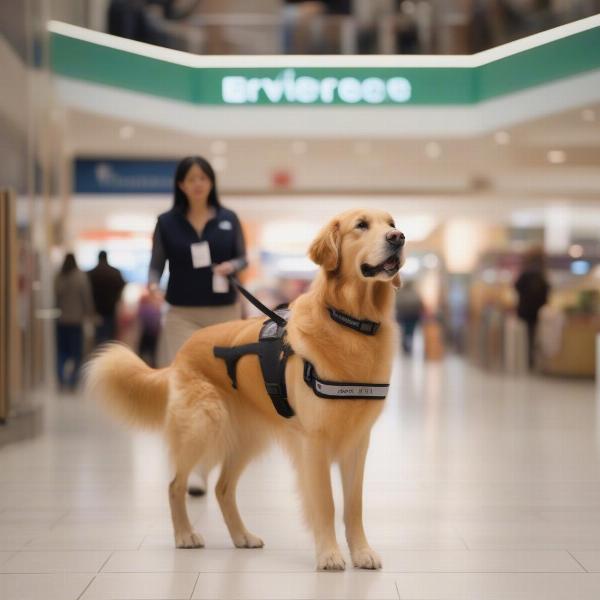Service dogs play a vital role in the lives of individuals with disabilities, providing assistance and enhancing independence. A common question surrounding service dogs is whether they are required to be on a leash. While the answer isn’t always a simple yes or no, understanding the laws and best practices surrounding leashing your service dog is crucial for both the handler and the dog’s well-being. This article will explore the nuances of leashing service dogs, addressing common misconceptions and providing valuable insights for responsible handling.
Leash Laws and Service Dogs: Navigating the Complexities
In most places, service dogs are not exempt from general leash laws. However, the Americans with Disabilities Act (ADA) in the United States, and similar legislation in other countries, provides specific guidelines regarding service dog handling. These guidelines emphasize the importance of maintaining control over the service dog at all times. While a leash is the most common and effective way to demonstrate control, it’s not the only method. Other methods, such as voice control or electronic collars, are permissible if they effectively maintain control and do not interfere with the dog’s work.
 Service dog on leash in a public place
Service dog on leash in a public place
When a Leash is Not Required: Exceptions to the Rule
While a leash is generally recommended, there are certain situations where a service dog may not need to be leashed. For example, if the handler’s disability prevents them from physically handling a leash, or if the leash interferes with the dog performing a specific task, such as retrieving an item or opening a door, the dog may work off-leash. However, even in these situations, the handler must maintain control of the dog through other means, such as voice commands or hand signals. This exception highlights the importance of individualized assessment and training, tailoring the handling methods to the specific needs of the handler and the tasks performed by the dog.
Benefits of Leashing Your Service Dog: Ensuring Safety and Focus
Leashing your service dog provides several key benefits, contributing to the safety and well-being of both the dog and the handler. A leash helps prevent distractions, ensuring the dog remains focused on its tasks and avoids unwanted interactions with other people or animals. This is particularly important in public spaces, where distractions can be plentiful. Furthermore, a leash provides a clear visual cue to others that the dog is working, helping to minimize unwanted approaches or interruptions.
Training Your Service Dog for Leash Manners: Essential Skills for Public Access
Proper leash training is essential for any service dog. This includes teaching the dog to walk calmly beside the handler, avoid pulling or lunging, and respond reliably to commands. Consistent and positive reinforcement training methods are crucial for achieving success. Specialized service dog training programs often incorporate advanced leash skills, preparing the dog for various environments and situations.
Choosing the Right Leash: Finding the Perfect Fit for Your Service Dog
Selecting the appropriate leash is essential for comfort and control. Consider factors such as the dog’s size, strength, and the specific tasks it performs. A standard 6-foot leash is generally suitable for most service dogs, offering a balance between freedom and control. Durable materials and comfortable handles are important considerations for the handler’s well-being.
Conclusion
Leashing a service dog is a multifaceted issue, requiring careful consideration of various factors. While leash laws apply in most public spaces, exceptions exist for specific situations where a leash may interfere with the dog’s work or the handler’s disability. Ultimately, the focus should always be on maintaining control of the service dog, ensuring its safety, and allowing it to perform its essential tasks effectively. Responsible handling and proper training are key to successful service dog partnerships, promoting seamless integration and enhancing the lives of individuals with disabilities.
FAQ
- Do service dogs always have to be on a leash? Not always. While leash laws generally apply, exceptions exist if the leash interferes with the dog’s work or the handler’s disability. Control must be maintained through other means.
- What are alternative ways to control a service dog without a leash? Voice commands, hand signals, and electronic collars are permissible alternatives if they effectively maintain control.
- Is it legal to ask a handler why their service dog is not on a leash? No. Inquiring about a person’s disability or the specifics of their service dog’s work is generally not permitted.
- What type of leash is best for a service dog? A standard 6-foot leash made of durable material is typically recommended.
- Where can I find more information on service dog laws and regulations? Consult the Americans with Disabilities Act (ADA) website or similar legislation in your country for specific guidelines.
- Are service dogs in training required to be on a leash? Generally, yes. Service dogs in training are still learning and require consistent control through a leash.
- Can a service dog be off-leash in my own home? Yes, within the privacy of your own home, a service dog can be off-leash.
ILM Dog is a leading international dog website dedicated to providing expert advice and resources on all aspects of dog care and well-being. From breed selection to health and training, we offer a comprehensive platform for dog owners worldwide. Whether you’re a seasoned dog owner or just starting your journey, ILM Dog has the information you need. Contact us at [email protected] or +44 20-3965-8624 for personalized guidance.